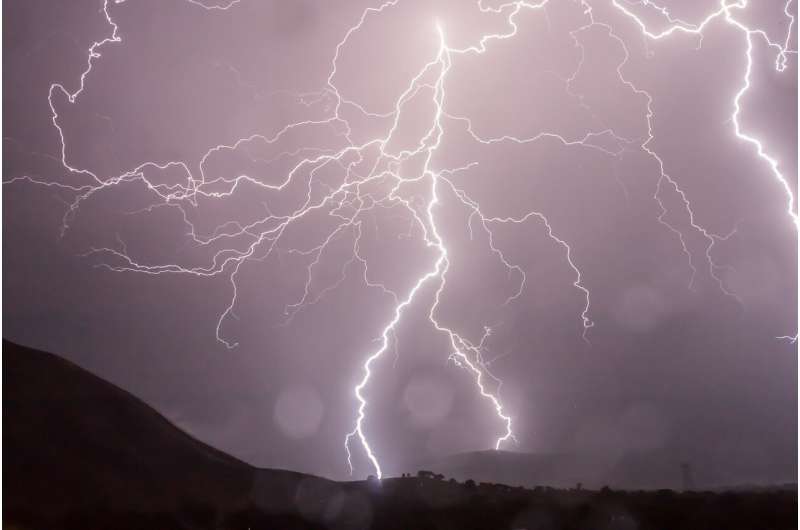Nepal's unique lightning signature involves up to four strikes per flash

While every lightning flash is unique in the way the discharge travels through the atmosphere, whether cloud-to-cloud, cloud-to-ground or the more esoteric sprites, halos, jets, and elves of the upper atmosphere. There are common features in these different types of lightning and for cloud-to-ground flashes, it has been assumed that there are two main types of flash known to meteorologists and atmospheric scientists—negative ground flashes and positive ground flashes.
The difference between the negative and positive flash is simply that the polarity of the discharge reaching the ground in the lightning flash. Most (90 percent) cloud-to-ground flashes are negative ground flashes. Just 10 percent are positive. The positive ground flash involves a single stroke. However, writing in the International Journal of Hydrology Science and Technology, physicist Pitri Bhakta Adhikari of the Tribhuvan University in Kathmandu, Nepal, explains a novel phenomenon seen in the sub-tropical, mountainous region of Nepal.
He has used a simple circuit and antenna system to measure the electrical signature of lightning flashes in the Himalayan region and found that positive ground flashes there are unique. Instead of involving a single strike, lightning here involves up to four strikes per flash, or discharge.
Adhikari explains that the lightning signature in this region is characterized by a relatively slow, negative electric field event preceded by a pronounced opposite-polarity pulse. The average duration of the main waveform was about 500 microseconds and the average duration of the preceding opposite-polarity pulses was approximately 40 microseconds. These figures are based on measurements of more than 5000 lightning flashes.
A likely explanation may lie in the fact that Nepal has regions that are a mere 60 metres above sea level and then within just 160 kilometres we can figuratively scale the giddy heights of Mount Everest, the peak at 8848 metres above sea level. Moreover across this altitude gradient and through the course of the seasons, Nepal can have a temperature ranging from a balmy 30 degrees Celsius down to –50 Celsius. All such characteristics are unique of themselves and so it is perhaps no surprise that the lightning seen in this region is unique too.
It is worth pointing out that lightning signatures not dissimilar to the unique flashes measured in Nepal have been seen occasionally in Sweden and Florida but not at anything like the frequency compared to other flashes seen in Nepal.
More information: Pitri Bhakta Adhikari, Unique lightning signatures observed from sub-tropical, mountainous country, Nepal, International Journal of Hydrology Science and Technology (2021). DOI: 10.1504/IJHST.2021.115488
Provided by Inderscience




















